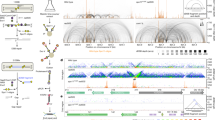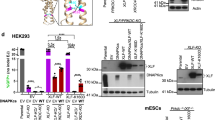Abstract
NON-HOMOLOGOUS repair of broken chromosomes in Saccharomyces cerevisiae can be studied at a defined location by expressing the site-specific HO endonuclease that cuts the mating-type (MAT) locus. When homologous recombination is prevented, most double-strand breaks are repaired by non-homologous end-joinings similar to those observed in mammalian cells. About 1% of non-homologous repair events were exceptional, having 'captured' approximately 100 base pairs of DNA within the HO cleavage site. In each case, the insertion came from yeast's retrotransposon Tyl element. Four of the five contained the R-U5 region, which is the first part of Tyl messenger RNA to be converted to complementary DNA. The capture of cDNA fragments at the sites of double-strand breaks may account for the way that pseudogenes and long and short interspersed sequences (LINES and SINES) have been inserted at many locations in the mammalian genome.
This is a preview of subscription content, access via your institution
Access options
Subscribe to this journal
Receive 51 print issues and online access
$199.00 per year
only $3.90 per issue
Buy this article
- Purchase on Springer Link
- Instant access to full article PDF
Prices may be subject to local taxes which are calculated during checkout
Similar content being viewed by others
References
Haber, J. E. BioEssays 17, 609–620 (1995).
Roth, D. & Wilson, J. H. in Genetic Recombination (eds Kucherlapati, R. & Smith, G. R.) 621–653 (American Society for Microbiology, Washington DC, 1988).
Pfeiffer, P., Throde, S., Hanke, J. & Vielmetter, W. Mol. Cell. Biol 14, 888–895 (1994).
Kramer, K. M., Brock, J. A., Bloom, K., Moore, J. K. & Haber, J. E. Mol. Cell. Biol. 14, 1293–1301 (1994).
Moore, J. K. & Haber, J. E. Mol. Cell. Biol. 16, 2164–2173 (1996).
Jensen, R. & Herskowitz, I. Cold Spring Harb. Symp. Quant. Biol. 49, 97–104 (1984).
Connolly, B., White, C. I. & Haber, J. E. Mol. Cell. Biol. 8, 2342–2349 (1988).
Hauber, J., Nelbock, J. H. & Feldmann, H. Nucleic Acids Res. 13, 2745–2758 (1985).
Voytas, D. F. & Boeke, J. D. Trends Genet. 9, 421–427 (1993).
Clare, J. & Farabaugh, P. Proc. Natl Accad. Sci. USA 82, 2829–2833 (1985).
Boeke, J. D. & Corces, V. G. Annu. Rev. Microbiol. 43, 403–434 (1989).
Chapman, K. B., Bystrom, A. S. & Boeke, J. D. Proc. Natl Acad. Sci. USA 89, 3236–3240 (1992).
Nickoloff, J. A., Singer, J. D., Hoekstra, M. F. & Heffron, F. J. Mol. Biol. 207, 527–541 (1989).
Boeke, J. D., Xu, H. & Fink, G. R. Science 239, 280–282 (1988).
Errede, B., Company, M. & Swanstrom, R. Mol. Cell. Biol. 6, 1334–1338 (1986).
Mézard, C. & Nicolas, A. Mol. Cell. Biol. 14, 1278–1292 (1994).
Teng, S.-C., Kim, B. & Gabriel, A. Nature 383, 641–644 (1986).
Derr, L. K., Strathern, J. N. & Garfinkel, D. J. Cell 67, 355–364 (1991).
Müller, F., Laufer, W., Pott, U. & Ciriacy, M. Mol. Gen. Genet. 226, 145–153 (1991).
Yang, J., Zimmerly, S., Perlman, P. S. & Lambowitz, A. M. Nature 381, 332–335 (1996).
Britten, R. J., Stout, D. B. & Davidson, E. H. Proc. Natl Acad. Sci. USA 85, 4770–4774 (1988).
Shen, M. R., Batzer, M. A. & Deininger, P. L. J. Mol. Evol. 33, 311–320 (1991).
Author information
Authors and Affiliations
Rights and permissions
About this article
Cite this article
Moore, J., Haber, J. Capture of retrotransposon DNA at the sites of chromosomal double-strand breaks. Nature 383, 644–646 (1996). https://doi.org/10.1038/383644a0
Received:
Accepted:
Issue Date:
DOI: https://doi.org/10.1038/383644a0
This article is cited by
-
Crosstalk between immune checkpoint and DNA damage response inhibitors for radiosensitization of tumors
Strahlentherapie und Onkologie (2023)
-
Frequency and mechanisms of LINE-1 retrotransposon insertions at CRISPR/Cas9 sites
Nature Communications (2022)
-
Diverse transposable element landscapes in pathogenic and nonpathogenic yeast models: the value of a comparative perspective
Mobile DNA (2020)
-
Exosome-mediated horizontal gene transfer occurs in double-strand break repair during genome editing
Communications Biology (2019)
-
Dna2 nuclease deficiency results in large and complex DNA insertions at chromosomal breaks
Nature (2018)
Comments
By submitting a comment you agree to abide by our Terms and Community Guidelines. If you find something abusive or that does not comply with our terms or guidelines please flag it as inappropriate.



